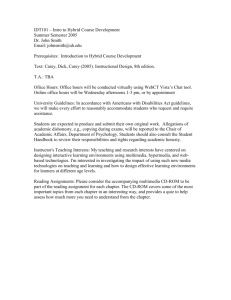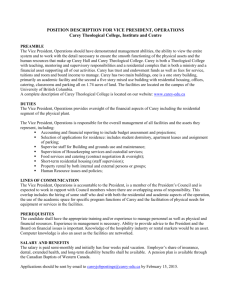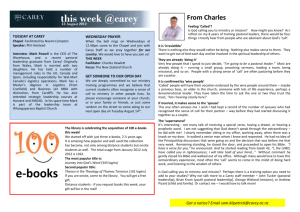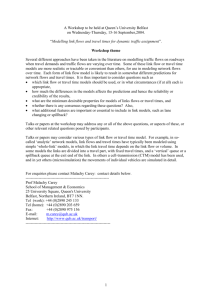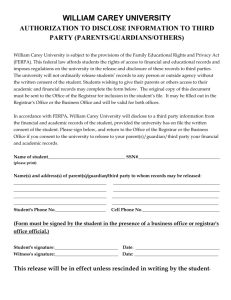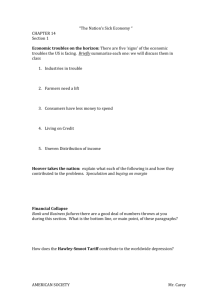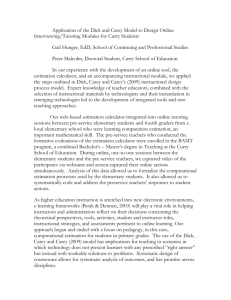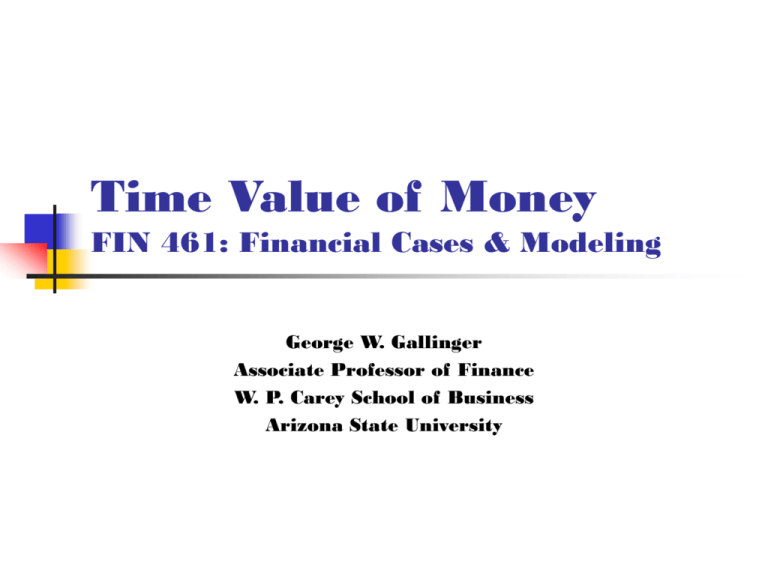
Time Value of Money
FIN 461: Financial Cases & Modeling
George W. Gallinger
Associate Professor of Finance
W. P. Carey School of Business
Arizona State University
Simple Interest
W. P. Carey School of Business
Slide 2
More Simple Interest …
W. P. Carey School of Business
Slide 3
Compound Interest:
A FV Perspective
W. P. Carey School of Business
Slide 4
Compounding …
W. P. Carey School of Business
Slide 5
Time Line: $78.35 Invested
(5
Years, 5% Interest)
FV5 = $100
PV = $78.35
0
1
2
3
4
5
End of Year
W. P. Carey School of Business
Slide 6
Future Value of $200
(4 Years, 8% Interest )
FV4 = $272.10
FV3 = $251.94
FV2 = $233.28
FV1 = $216
PV = $200
0
1
2
3
4
End of Year
Compounding – the process of earning
interest in each successive year
W. P. Carey School of Business
Slide 7
FV of a Mixed Cash Flow
Stream (5 Years, 5.5% Interest)
FV5 = $16,689.06
$4,335.89
$4,462.12
$2,226.06
$3,165.00
$2,500.00
0
$3,500
$3,800
$2,000
1
2
3
$3,000
4
$2,500
5
End of Year
W. P. Carey School of Business
Slide 8
Future Value Example
W. P. Carey School of Business
Slide 9
Power Of Compound Interest
30.00
20%
25.00
20.00
15%
15.00
10.00
5.00
1.00
10%
5%
0%
0 2 4 6 8 10 12 14 16 18 20 22 24
Periods
W. P. Carey School of Business
Slide 10
Format of a Future Value
Interest Factor (FVIF) Table
Period
1
2
3
4
5
6
7
1%
1.010
1.020
1.030
1.041
1.051
1.062
1.072
2%
1.020
1.040
1.061
1.082
1.104
1.126
1.149
W. P. Carey School of Business
3%
1.030
1.061
1.093
1.126
1.159
1.194
1.230
4%
1.040
1.082
1.125
1.170
1.217
1.265
1.316
5%
1.050
1.102
1.158
1.216
1.276
1.340
1.407
6%
1.060
1.124
1.191
1.262
1.338
1.419
1.504
Slide 11
Computing Future Values
Using Excel
You deposit $1,000 today at 3% interest.
How much will you have in 5 years?
PV
r
n
FV?
$
1,000
3.00%
5
$1,159.3
W. P. Carey School of Business
Excel Function
=FV (interest, periods, pmt, PV)
=FV (.03, 5, ,1000)
Slide 12
Present Value with
Compounding
W. P. Carey School of Business
Slide 13
Present Value of $500
(7 Years, 6% Discount Rate)
0
1
2
3
4
End of Year
5
6
7
FV7 = $500
PV = $332.53
W. P. Carey School of Business
Slide 14
Present Value of Future
Amounts (4 Years, 7% Interest )
Discounting
0
1
FV1 = $214
2
FV2 = $228.98
3
FV3 = $245
4
FV4 = $262.16
End of Year
PV = $200
What if the interest rate goes up to 8% ?
W. P. Carey School of Business
Slide 15
PV of a Mixed Stream
(4 Years, 6% Interest)
0
1
2
$1,500,000
$3,000,000
3
$2,000,000
4
$5,000,000
End of Year
$1,415,100
$2,669,700
$1,679,200
$3,960,500
PV4 = $9,724,500
W. P. Carey School of Business
Slide 16
Present Value Examples
W. P. Carey School of Business
Slide 17
Power Of High Discount
Rates: PV of $1
1.00
0%
0.75
0.5
5%
0.25
10%
15%
20%
0 2 4 6 8 10 12 14 16 18 20 22 24
Periods
W. P. Carey School of Business
Slide 18
Format of a Present Value
Interest Factor (PVF) Table
Period
1
2
3
4
5
6
7
1%
0.990
0.980
0.971
0.961
0.951
0.942
0.933
2%
0.980
0.961
.942
0.924
0.906
0.888
0.871
W. P. Carey School of Business
3%
0.971
0.943
0.915
0.888
0.863
0.837
0.813
4%
0.962
0.925
0.889
0.855
0.822
0.790
0.760
5%
0.952
0.907
0.864
0.823
0.784
0.746
0.711
6%
0.943
0.890
0.840
0.792
0.747
0.705
0.665
Slide 19
Calculating PV Of A Single
Amount Using Excel
Example: How much must you deposit today in order
to have $500 in 7 years if you can earn 6% interest on
your deposit?
FV
r
n
PV?
$
500
6.00%
7
$332.5
W. P. Carey School of Business
Excel Function
=PV (interest, periods, pmt, FV)
=PV (.06, 7,,500)
Slide 20
FV & PV of Mixed Stream
(5 Years, 4% Interest Rate)
Compounding
- $12,166.5
$3,509.6
$5,624.3
$4,326.4
FV
$6,413.8
$3,120.0
-$10,000
0
$3,000
$5,000
1
$2,884.6
2
$4,000
$3,000
3
4
$2,000.0
5
End of Year
$4,622.8
PV
$5,271.7
$3,556.0
$2,564.4
$1,643.9
W. P. Carey School of Business
Discounting
Slide 21
Change the Flows
Assume constant flows
Over an explicit period
Forever called perpetuity.
W. P. Carey School of Business
Slide 22
Annuity Cash Flows
W. P. Carey School of Business
Slide 23
FV of Ordinary Annuity
(End of 5 Years, 5.5% Interest Rate)
$1,238.82
$1,174.24
$1,113.02
$1,055.00
$1,000.00
0
$1,000
$1,000
$1,000
1
2
3
$1,000
End of Year
4
$1,000
5
(1 r ) 1
FV PMT
$5,581.08
r
n
W. P. Carey School of Business
Slide 24
FV of an Ordinary Annuity
Using Excel
How much will your deposits grow to at the end of five years if you
deposit $1,000 at the end of each year at 4.3% interest for 5 years?
PMT
r
n
FV?
$
1,000
4.3%
5
$5,448.8
Excel Function
=FV (interest, periods, pmt, PV)
=FV (.043, 5,1000 )
How is annuity due different ?
W. P. Carey School of Business
Slide 25
PV of Ordinary Annuity
(5 Years, 5.5% Interest)
0
1
$1,000
2
$1,000
3
$1,000
4
$1,000
5
$1,000
End of Year
$947.87
$898.45
$851.61
$807.22
$765.13
PMT
1
PV
1
$4,270.28
n
r
(1 r )
W. P. Carey School of Business
Slide 26
Annuity Examples
W. P. Carey School of Business
Slide 27
Ordinary Annuity vs. An
Annuity Due
Annual Cash Flows
End of yeara
Annuity A (ordinary)
0
$
Annuity B (annuity due)
0
$1,000
1
1,000
1,000
2
1,000
1,000
3
1,000
1,000
4
1,000
1,000
5
1,000
0
Total
$5,000
$5,000
aThe
ends of years 0, 1,2, 3, 4 and 5 are equivalent to the beginnings of years
1, 2, 3, 4, 5, and 6 respectively
W. P. Carey School of Business
Slide 28
Calculating the Future Value
of an Annuity Due
•
Equation for the FV of an ordinary annuity can be converted
into an expression for the future value of an annuity due,
FVAn (annuity due), by merely multiplying by (1 + r)
n
FVAn (annuity due) PMT (1 r )t 1 (1 r )
t 1
n
PMT (1 r ) t
t 1
(1 r ) n 1
FV PMT
1 r
r
W. P. Carey School of Business
Slide 29
FV of an Annuity Due
Using Excel
How much will your deposits grow to at the end of five years
if you deposit $1,000 at the beginning of each year at 4.3%
interest for 5 years?
PMT
r
n
FV
FVA?
$1,000
4.30%
5
$5,448.89
$5,683.19
W. P. Carey School of Business
Excel Function
=FV (interest, periods, pmt, PV)
=FV (.043, 5, 1000)
=$5,448.89*(1.043)
Slide 30
PV of Perpetuity
($1,000 Payment, 7% Interest Rate)
Stream of equal annual cash flows that lasts “forever”
PV PMT
t 1
1
t
(1 r )
1
PV PMT $14,285 .71
r
What if the payments grow at 2% / year?
W. P. Carey School of Business
Slide 31
PV of Growing Perpetuity
CF1
PV
rg
0
1
$1,000
2
$1,020
3
$1,040.4
rg
4
$1,061.2
5
$1,082.4
…
Growing perpetuity
CF1 = $1,000
r = 7% per year
g = 2% per year
W. P. Carey School of Business
PV $20,000
Slide 32
Frequency of Compounding
Discussion so far
Assumed annual flows
No need to be the case.
W. P. Carey School of Business
Slide 33
Compounding More
Frequently than Annually
Can compute interest with semi-annual, quarterly,
monthly (or more frequent) compounding periods
To change basic FV formula to m compounding
periods:
Semi-annual interest computed twice per year
Quarterly interest computed four times per year
Divide interest rate r by m and
Multiply number of years n by m
Basic FV formula becomes:
r
FVn PV 1
m
W. P. Carey School of Business
mn
Slide 34
Compounding More
Frequently than Annually …
FV at end of 2 years of $125,000 deposited at 5.13% interest
– For semiannual compounding, m = 2:
22
0.0513
FV2 $125,000 1
$138,326.93
2
4
– For quarterly compounding, m = 4:
0.0513
FV2 $125,000 1
4
W. P. Carey School of Business
42
$138,415.687
Slide 35
Continuous Compounding
In Extreme Case, Interest is compounded continuously
FVn = PV x (e
r x n)
e = 2.7183…
FV at end of 2 years of $125,000 at 5.13 % annual interest,
compounded continuously
FVn = $138,506.01
W. P. Carey School of Business
Slide 36
More Frequent
Compounding, Larger the FV
FV of $100 at end of 2 years, invested at 8% annual interest,
compounded at the following intervals:
Annually:
FV = $100 (1.08)2
= $116.64
Semi-annually:
FV = $100 (1.04)4
= $116.99
Quarterly:
FV = $100 (1.02)8
= $117.17
Monthly:
FV = $100 (1.0067)24
= $117.30
Continuously:
FV = $100 (e
= $117.35
W. P. Carey School of Business
0.16)
Slide 37
What’s the True Interest
Rate?
Quoted or otherwise?
Otherwise!
W. P. Carey School of Business
Slide 38
APR vs. EAR
W. P. Carey School of Business
Slide 39
APR vs. EAR …
W. P. Carey School of Business
Slide 40
APR vs. EAR …
W. P. Carey School of Business
Slide 41
Effective Rates ≥ Nominal
Rates
For annual compounding, effective = nominal
1
0.08
EAR 1
1 (1 0.08) 0.08 8.0%
1
For semi-annual compounding
2
0.08
EAR 1
1 1.0816 1 0.0816 8.16%
2
For quarterly compounding
4
0.08
EAR 1
1 1.0824 1 0.0824 8.24%
4
W. P. Carey School of Business
Slide 42
Applications of TVM
W. P. Carey School of Business
Slide 43
Deposits Needed to
Accumulate a Future Sum
A person wishes to buy a house 5 years from now
and estimates an initial down payment of $35,000 will be
required at that time
She wishes to make equal annual end-of-year deposits in an
account paying annual interest of 4 percent, so she must
determine what size annuity will result in a lump sum equal to
$35,000 at the end of year 5
Find the annual deposit required to accumulate FVAn dollars,
given an interest rate, r, and a certain number of years, n by
solving equation PMT:
FVA5
$35,000
PMT
$6,461.98
FVIFA4%, 5 5.4163
W. P. Carey School of Business
Slide 44
Loan Amortization Table
(10% interest, 4 Year Term)
Payments
End
of
year
Loan
Payment
(1)
Beginningof-year
principal
(2)
Interest
[.10 x (2)]
(3)
End-of-year
Principal
principal
[(1) – (3)]
[(2) – (4)]
(4)
(5)
$1,292.82 $4,707.18
1
$1,892.82
$6,000.00
$600.00
2
1,892.82
4,707.18
470.72
1,422.10
3,285.08
3
1,892.82
3,285.08
328.51
1,564.31
1,720.77
4
1,892.82
1,720.77
172.08
1,720.74
-a
aDue
to rounding, a slight difference ($.03) exists between beginning-of-year 4
principal (in column 2) and the year-4 principal payment (in column 4)
W. P. Carey School of Business
Slide 45
Finding Growth Rates
At times, it may be desirable to determine the compound interest rate or
growth rate implied by a series of cash flows.
For example, assume you invested $1,000 in a mutual fund in 1997 which grew
as shown in the table below.
What compound growth rate did this investment achieve?
1997 $ 1,000
1998
1,127
1999
1,158
2000
2,345
2001
3,985
2002
4,677
2003
5,525
W. P. Carey School of Business
It is first important to note
that although there are 7
years show, there are only 6
time periods between the
initial deposit and the final
value.
Slide 46
Determining Growth Rates
Using Excel
This chart shows that $1,000 is the present value, the future value is $5,525,
and the number of periods is 6
Want to find the rate, r, that would cause $1,000 to grow to $5,525 over a
six-year compounding period
Use FV formula: FV= PV x (1+r)n $5,525=$1,000 x (1+r)6
Simplify & rearrange: (1+r)6 = $5,525 $1,000 = 5.525
Find sixth root of 5.525 (Take yx, where x=0.16667), subtract 1
Find r = 0.3296, so growth rate = 32.96%.
1997 $
1998
1999
2000
2001
2002
2003
1,000
1,127
1,158
2,345
3,985
4,677
5,525
W. P. Carey School of Business
Excel Function
=Rate(periods, pmt, PV, FV)
=Rate(6, ,1000, 5525)
Slide 47
The End of TVM Discussion
W. P. Carey School of Business
Slide 48
Risk & Return Concepts
FIN 461: Financial Cases & Modeling
George W. Gallinger
Associate Professor of Finance
W. P. Carey School of Business
Arizona State University
100,000
Equities
Bills
Bonds
Inflation
Total value of reinvested
returns, year-end 2000
$
10,000
10,000
Returns On U.S.
Asset Classes,
1900-2000,
In Nominal Terms
1,000
119
100
70
24
10
1
Annual returns
W. P. Carey School of Business
Source: Dimson, Marsh &
Staunton (ABN/AMRO),
Millenium Book II (2001)
Slide 50
Rates of Return
1926-1999
60
40
20
0
-20
Common Stocks
Long T-Bonds
T-Bills
-40
-60 26
30
35
40
45
50
55
60
65
70
75
80
85
90
95
Source: © Stocks, Bonds, Bills, and Inflation 2000 Yearbook™, Ibbotson Associates, Inc., Chicago (annually updates work by
Roger G. Ibbotson and Rex A. Sinquefield). All rights reserved.
W. P. Carey School of Business
Slide 51
Stock Market Volatility
The volatility of stocks is not constant from year to year.
60
50
40
30
20
10
19
26
19
35
19
40
19
45
19
50
19
55
19
60
19
65
19
70
19
75
19
80
19
85
19
90
19
95
19
98
0
Source: © Stocks, Bonds, Bills, and Inflation 2000 Yearbook™, Ibbotson Associates, Inc., Chicago (annually updates work by
Roger G. Ibbotson and Rex A. Sinquefield). All rights reserved.
W. P. Carey School of Business
Slide 52
Portfolio Returns
(1926 – 1999)
Large Company Stocks versus Small Company Stocks
-80 -70 -60 -50 -40 -30 -20 -10 0 10 20 30 40 50 60 70 80 90
W. P. Carey School of Business
-80
-60
-40
-20
0
20
40
60
80
100130
150
Slide 53
Historical Trade-Off Between
Risk & Return, 1926-2000
Nominal
return
Real (inflationadjusted) return
Standard
deviation
Small company stocks
12.4%
9.3%
33.4%
Large company stocks
11.0
7.9
20.2
Long-term corporate
bonds
Long-term government
bonds
Intermediate-term
government bonds
U.S. Treasury bills
5.7
2.6
8.7
5.3
2.2
9.4
5.3
2.2
5.8
3.8
.07
3.2
Inflation
3.1
--
4.4
Series
W. P. Carey School of Business
Slide 54
Risk Premiums
Rate of return on T-bills is essentially risk-free
Investing in stocks is risky, but there are
compensations
Difference between the return on T-bills and
stocks is the risk premium for investing in
stocks
An old saying on Wall Street is “You can
either sleep well or eat well.”
W. P. Carey School of Business
Slide 55
Historical Trade-Off Between
Risk & Return, 1926-2000
Nominal
return
Real (inflationadjusted) return
Standard
deviation
Small company stocks
12.4%
9.3%
33.4%
Large company stocks
11.0
7.9
20.2
Long-term corporate
bonds
Long-term government
bonds
Intermediate-term
government bonds
U.S. Treasury bills
5.7
2.6
8.7
5.3
2.2
9.4
5.3
2.2
5.8
3.8
.07
3.2
Inflation
3.1
--
4.4
Series
W. P. Carey School of Business
Slide 56
Equity Risk Premia Around
the World
W. P. Carey School of Business
Slide 57
Defining Financial Risk &
Return
Risk variability of returns associated with a given
asset
Return total gain or loss experienced on an
investment over a given period of time
Return measured as the change in an asset's value plus any
cash distributions (dividends or interest payments)
Pt 1 Pt Ct 1
Rt 1
Pt
Pt+1 = price (value) of asset at time t+1;
Pt = price (value) of asset at time t;
Ct+1 = cash flow paid by time t+1.
W. P. Carey School of Business
Slide 58
Calculating Realized Returns
on Two Stocks
Stocks purchased 12/31/02 and sold 12/31/03
Calculating one-year realized return for each investment
Dynatech, bought for $60/share (P0), pays no dividends (Ct=0),
sold for $72/share (P1)
Utilityco, bought for $60/share (P0), pays $6/share dividend
(Ct=$6), sold for $66/share
$72 - $60 + 0 $12
] [
] 20%
R dyn = [
$60
$60
$66 - $60 + $6 $12
] [
] 20%
R util = [
$60
$60
Both have 20% return, one pure cap gains; one cap gains and dividends.
W. P. Carey School of Business
Slide 59
Measuring Expected Return
W. P. Carey School of Business
Slide 60
Plot of Historical Returns
Both Express Air
and Synerdyne
have an
expected return
of 9%
Express Air has
less variability
in returns than
does
Synerdyne.
W. P. Carey School of Business
Slide 61
Probability Density
Same Expected Return;
Different Distributions
Express Air
Synerdyne
0
4
5
6
7
8
9
10
11
12
13
14
Return %
W. P. Carey School of Business
Slide 62
Risk = Standard Deviation
(At Least for Now)
W. P. Carey School of Business
Slide 63
Risk Aversion
People seek
to minimize
risk for a
given
expected
return--or
maximize
return for a
given risk
exposure.
W. P. Carey School of Business
Slide 64
Let’s Form a Portfolio
Assume two assets included.
W. P. Carey School of Business
Slide 65
Calculating the Portfolio’s
Return
Assume a 2 security portfolio:
--40% invested in security #1 which expects to earn 8%
--60% invested in security #2 which expects to earn 17%
W. P. Carey School of Business
Slide 66
Calculating the Portfolio’s
Standard Deviation (No Correlation)
W. P. Carey School of Business
Slide 67
Calculating the Portfolio’s
Standard Deviation (Correlation)
W. P. Carey School of Business
Slide 68
Perfectly Positively, Perfectly
Negatively Correlated Assets
Perfectly Positively Correlated
Perfectly Negatively Correlated
B
Return
Return
B
A
Time
W. P. Carey School of Business
A
Time
Slide 69
Imperfectly Correlated Assets
& Portfolio Variability
Combining two imperfectly correlated assets into a portfolio
reduces the variability of portfolio returns
Asset M
Asset N
Return
Return
Time
W. P. Carey School of Business
Time
Portfolio of
Asset M and N
Return
Time
Slide 70
Effect of Correlation on
Diversification
W. P. Carey School of Business
Slide 71
Expected Return & Standard
Deviation, Two Asset Portfolio
E(RP)
efficient portfolios
•C
•
•B
(50%A, 50%B)
MVP (75%A, 25%B)
•A
A & B seem imperfectly correlated: -1< AB <+1
Curve connecting A & B called the feasible set of portfolios
Only portfolios from minimum variance p/f (MVP) to B are efficient
inefficient portfolios
P
W. P. Carey School of Business
Slide 72
Efficient Frontier with Many
Assets
E(RP)
Investors have many
assets to choose from
efficient portfolios
MVP
•
•
•
•
A
•
•
•
•
B
•
•
•
•C
•
•
• •
•
•
Each dot represents
individual security
Feasible set consists of
all possible p/fs
Only p/fs on upward
sloping edge from MVP
are efficient
A,B,C are inefficient:
portfolios on frontier offer
higher return for same
risk or same return for
lower risk
P
W. P. Carey School of Business
Slide 73
Expanding the Feasible Set on
the Efficient Frontier
E(RP)
EF including domestic
& foreign assets
Expanding
universe of
investment
assets expands
efficient frontier
Include nonequity assets:
bonds, real
estate, art, gold
& international
assets
Basic point:
Investors always
stay on efficient
frontier
Appetite for risk
determines
exactly where.
W. P. Carey School of Business
EF including domestic
stocks, bonds, and
real estate
EF for portfolios of
domestic stocks
P
Slide 74
Revisit “Calculating the
Portfolio’s Standard Deviation”
W. P. Carey School of Business
Slide 75
Declining Importance of Own
Variance
Whatever the correlation between assets, increasing
the number of assets in a portfolio reduces the
impact of each one’s own variance
Demonstrate with two assets, assuming equal
weights of each stock (wj = wl = 0.5):
p2 = wj 2j2 + (1-wj)2l2 + 2 wj (1-wj) Cov(j,l)
= (0.5)2j2 + (0.5)2l2 + 2(0.5)(0.5)Cov(j,l)
Each asset’s own variance accounts for only 25% of
total portfolio variance, and both own variances
together only total half.
W. P. Carey School of Business
Slide 76
Add More Assets
Addition of more assets causes
individual variances to decline in
importance
Covariance amounts are important.
W. P. Carey School of Business
Slide 77
Variance – Covariance Matrix
Asset
1
1
2
2
1 2
1
5
2
1
12
5
3
4
1
13
5
2
1
14
5
2
1
15
5
2
1
24
5
2
1
25
5
2
1
21
5
3
1
31
5
2
1
32
5
2
1 2
3
5
2
1
34
5
4
1
41
5
2
1
51
5
2
1
42
5
2
1
52
5
2
1
43
5
2
1
53
5
2
1 2
4
5
2
1
54
5
5
2
2
1
23
5
1 2
2
5
5
2
2
2
1
35
5
2
2
1
45
5
2
1 2
5
5
2
Variance of individual assets account only for 1/25th of the portfolio variance
Covariance terms determine a large extent of portfolio variance.
W. P. Carey School of Business
Slide 78
Important Discovery
Emerges
Treat as two asset portfolio
Asset #1 Risk-free Treasury security
Asset #2 Market portfolio.
W. P. Carey School of Business
Slide 79
CML & Efficient Frontier
W. P. Carey School of Business
Slide 80
Return
Market Equilibrium
M
rf
P
With the capital allocation line identified, all investors choose a
point along the line—some combination of the risk-free asset
and the market portfolio M. In a world with homogeneous
expectations, M is the same for all investors.
W. P. Carey School of Business
Slide 81
Portfolios Of Risky & Risk-Free
Assets
E(RP)
A = 50% risky,
50% risk-free
100% risky
B = 150% risky
CML
12%
•
10%
8%
RF=6% •
0
•
•
8.16%
W. P. Carey School of Business
16.33%
24.49%
P
Slide 82
New Efficient Frontier
new efficient frontier
E(RP)
old efficient frontier
• M – Only this risky portfolio
is efficient
RF
•
0
• MVP
•
L1
X
P
All efficient portfolios consist of some combination of the risk-free asset and risky portfolio M.
W. P. Carey School of Business
Slide 83
Portfolios Of Risky & RiskFree Assets
new efficient frontier
E(RP)
•
16.5%
•M
12%
•A
9%
RF=6%
•
0
W. P. Carey School of Business
•
X
B
old efficient frontier
L1
All investors will hold combination of riskless asset and M
Between Rf and MF, allocating existing wealth (point A)
Above MF, borrowing at Rf, investing proceeds in MF (pt B)
30%
P
Slide 84
Portfolios Of Risky & RiskFree Assets: The CML
E(RP)
CML
•
16.5%
•M
12%
•A
9%
RF=6%
B
CML becomes new efficient frontier
Every investor chooses combination of portfolio M
and riskless asset: called two-fund separation
principle
•
0
15%
W. P. Carey School of Business
30%
52%
P
Slide 85
Risk Contribution of a Security
to a Diversified Portfolio
Ask:
How does the security change as the
market portfolio changes?
Is the asset
More risky?
Less risky?
As risky?
What’s the diversifiable risk?
W. P. Carey School of Business
Slide 86
Diversifiable & Market
Risks
W. P. Carey School of Business
Slide 87
Definition of Risk When
Investors Hold the Market
Portfolio
Researchers have shown that the best measure of
the risk of a security in a large portfolio is the beta
(b)of the security
Beta measures the responsiveness of a security to
movements in the market portfolio.
bi
W. P. Carey School of Business
Cov( Ri , RM )
( RM )
2
Slide 88
Measuring Beta
W. P. Carey School of Business
Slide 89
E(R) on an Individual Security:
Capital Asset Pricing Model
W. P. Carey School of Business
Slide 90
Estimating Betas
Collect data on a stock’s returns and returns
on a market index
Plot these points on a graph
Y–axis measures stock’s return
X-axis measures market’s return
Plot a line (using regression) through the
points
Slope of line equals beta
R-square value measures the percentage of risk
that is systematic.
W. P. Carey School of Business
Slide 91
Security Returns
Estimating b with
Regression
Slope = bi
Return on
market %
Ri = a i + biRm + ei
W. P. Carey School of Business
Slide 92
Scatterplot for Returns on
Sharper Image and S&P500
0.3
Sharper Image Weekly Return
January 2000 – May 2001
Slope = Beta = 1.44
0.2
0.1
0
-0.3
-0.2
-0.1
0
-0.1
0.1
0.2
0.3
R-square = 0.19
-0.2
-0.3
S&P500 Weekly Return
W. P. Carey School of Business
Slide 93
Scatterplot for Returns
on ConAgra and S&P500
0.15
ConAgra Weekly Return
January 2000 – May 2001
0.1
0.05
beta = 0.11
0
-0.15
-0.1
-0.05
0
0.05
0.1
0.15
-0.05
R-square = 0.003
-0.1
-0.15
S&P500 Weekly Return
W. P. Carey School of Business
Slide 94
Scatterplot for Returns on
Citigroup and S&P500
0.2
January 2000 – May 2001
Citigroup Weekly Return
0.15
beta = 1.20
0.1
0.05
0
-0.2
-0.15
-0.1
-0.05
0
0.05
0.1
0.15
0.2
-0.05
R-square = 0.50
-0.1
-0.15
-0.2
S&P500 Weekly Return
W. P. Carey School of Business
Slide 95
Betas of Individual Stocks
Stock
American Electric Power
AT&T Wireless
SBC Communications
Johnson Controls
Gillette
USG Corp
International Paper
Martha Stewart Living
Procter & Gamble
Kimberly-Clark
Beta
0.90
1.35
0.95
1.00
0.65
1.30
1.00
1.35
0.60
0.70
Stock
General Electric
JDS Uniphase
Intel
Apple Computer
Hewlett-Packard
Golden West Financial
Federal Realty Investmt
MetLife, Inc
Newmont Mining
Merck & Co
Beta
1.30
1.65
1.25
1.00
1.30
0.90
0.70
1.10
0.30
0.95
Source: Value Line investment Survey (New York: Value Line Publishing, January 3, 10, 17 & 24, 2003)
W. P. Carey School of Business
Slide 96
Using the Security Market
Line
r%
15
SML
The SML and where P&G and GE place on it
12.4%
Slope = E(Rm) – RF =
MRP = 10% - 2% = 8%
= Y ÷ X
•
10
6.8%
5
Rf = 2%
P&G
W. P. Carey School of Business
1
GE
2
b
Slide 97
Shift in Required Market
Return
r%
SML1
15
SML2
11.1%
•
•
10
Shift due to change in
market risk premium
from 8% to 7%
6.2%
5
Rf = 2%
P&G
W. P. Carey School of Business
1
GE
2
b
Slide 98
Shift in the Risk-Free Rate
SML2
r%
SML1
15
14.4%
Shift due to change in
risk-free rate from 2% to
4%, with market risk
premium remaining at
8%. Note all returns
increase by 2%
•
10
8.8%
5
Rf = 4%
P&G
W. P. Carey School of Business
1
GE
2
b
Slide 99
The Security Market Line
E(RP)
SML
A
•
RM
RF=6%
•
•
•
Slope = E(Rm) - RF = Market
Risk Premium (MRP)
B
•
b =1.0
W. P. Carey School of Business
bi
Slide 100
Measure of Systematic Risk
What If Beta
= 1?
What If Beta
> 1 or Beta
<1?
W. P. Carey School of Business
•
•
•
•
The stock moves 1% on average when the
market moves 1%
An “average” level of risk
The stock moves >1% on average when the
market moves 1% (Beta > 1)
The stock moves < 1% on average when the
market moves 1% (Beta < 1).
Slide 101
Interpreting Beta
Coefficients
Beta
2.0
1.0
.5
Comment
Move in same
direction as
market
-1.0
-2.0
Twice as responsive, or risky, as the market
Same response or risk as the market (I.e., average risk)
Only half as responsive, or risky, as the market
Unaffected by market movement
0
- .5
Interpretation
Move in opposite
direction as
market
W. P. Carey School of Business
Only half as responsive, or risky, as the market
Same response or risk as the market (I.e., average risk)
Twice as responsive, or risky, as the market
Slide 102
Some Cautions About Beta
Different financial services companies (e.g.,
Merrill Lynch) compute beta differently
Giving us different betas for the same company
A firm's beta is unstable over time
High beta stocks don't achieve returns as
high as expected
High beta stocks achieve good returns in up
markets but are punished in down markets
Beta may fail to work as theory suggests.
W. P. Carey School of Business
Slide 103
Calculating Required Return
Using the SML
E(RP)
Slope = E(Rm) – RF = MRP = 14% - 6% = 8% = Y ÷ X
SML
18%
RM=14%
10%
RF=6%
0.5
W. P. Carey School of Business
bi =1.0
1.5
bi
Slide 104
Example:
Calculating Expected Returns
E(Ri) = Rf + ß [E(Rm) – Rf ]
• Assume
• Risk–free rate = 2%
• Expected risk premium = 6%
If Stock’s Beta Is
Then Expected Return Is
0
2%
0.5
5%
1
8%
2
14%
When beta = 0, the return equals the risk-free return
When
beta
= 1, the return equals the expected market return.
W. P. Carey
School
of Business
Slide 105
Portfolio Betas?
Betas calculated for stocks
Thus, can calculate portfolio betas.
W. P. Carey School of Business
Slide 106
Portfolio Beta Calculation
W. P. Carey School of Business
Slide 107
Portfolio Performance:
Treynor Index
W. P. Carey School of Business
Slide 108
The End
W. P. Carey School of Business
Slide 109

